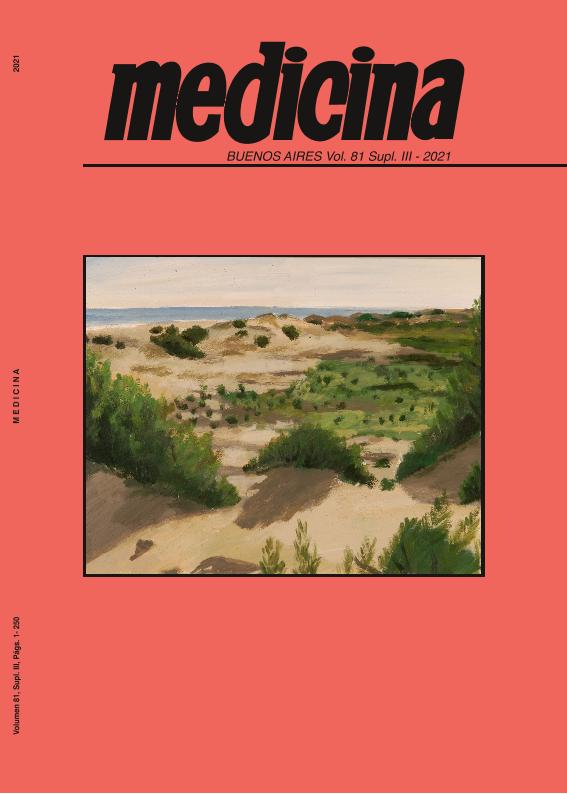Evento
Epidemiological surveilllance of Sars-Cov-2 ocurrence in wastewater from Gran San Miguel de Tucumán, Argentina
D'arpino, María Cecilia ; Bellomio, Augusto
; Bellomio, Augusto ; Saavedra, Maria Lucila
; Saavedra, Maria Lucila ; Sinelli, Pedro Eugenio; Sendín, Lorena Noelia
; Sinelli, Pedro Eugenio; Sendín, Lorena Noelia ; Adler, Conrado
; Adler, Conrado ; Hebert, Elvira Maria
; Hebert, Elvira Maria ; Migliavacca, Julieta; Gerstenfeld, Sabrina; Chahla, Rossana; Albarracín, Virginia Helena
; Migliavacca, Julieta; Gerstenfeld, Sabrina; Chahla, Rossana; Albarracín, Virginia Helena
 ; Bellomio, Augusto
; Bellomio, Augusto ; Saavedra, Maria Lucila
; Saavedra, Maria Lucila ; Sinelli, Pedro Eugenio; Sendín, Lorena Noelia
; Sinelli, Pedro Eugenio; Sendín, Lorena Noelia ; Adler, Conrado
; Adler, Conrado ; Hebert, Elvira Maria
; Hebert, Elvira Maria ; Migliavacca, Julieta; Gerstenfeld, Sabrina; Chahla, Rossana; Albarracín, Virginia Helena
; Migliavacca, Julieta; Gerstenfeld, Sabrina; Chahla, Rossana; Albarracín, Virginia Helena
Tipo del evento:
Reunión
Nombre del evento:
Reunión de Sociedades de Biociencias 2021; LXVI Reunión anual de la Sociedad Argentina de Investigación Clínica; LXIX Reunión anual de la Sociedad Argentina de Immunología; LIII Reunión anual de la Asociación Argentina de Farmacología Experimental; XI Reunión anual de la Asociación Argentina de Nanomedicinas
Fecha del evento:
17/11/2021
Institución Organizadora:
Sociedad Argentina de Investigación Clínica;
Sociedad Argentina de Inmunologia;
Asociación Argentina de Farmacología Experimental;
Asociación Argentina de Nanomedicinas;
Título de la revista:
Medicina (Buenos Aires)
Editorial:
Fundación Revista Medicina
ISSN:
0025-7680
e-ISSN:
1669-9106
Idioma:
Inglés
Clasificación temática:
Resumen
The ongoing global pandemic of coronavirus disease 2019 (COVID-19) caused by Severe Acute Respiratory Syndrome Coronavirus 2 (SARS-CoV-2) has been a public health emergency of international concern. SARS-CoV-2 is a member of the Coronaviridae family, consisting of a group of enveloped viruses with single-stranded RNA genomes which cause diseases ranging from common colds to acute respiratory distress syndrome. Although the main transmission routes for SARS-CoV-2 are the inhalation of aerosols/droplets and person-to-person contact, current evidence available indicates that the viral RNA is present in wastewater, suggesting the need to better understand this route as a potential source of epidemiological data and human health risks. To this aim, 32 sewage samples were collected between May and June 2020 from wastewater in the cities of San Miguel de Tucumán and Yerba Buena, Argentina. Before viral concentration, composite samples were heat inactivated to increase handling safety. Next, wastewater samples (200 ml) were mixed with polyethylene glycol (PEG) and NaCl. Mixtures were left to stand overnight at 4 °C. Subsequently, they were centrifuged, and pellets were resuspended in TRIZOL. The extraction of viral RNA was executed using the PURO VIRUS KIT (Productos BIO-Lógicos). A real-time RT-qPCR assay targeting the N gene, using SARSCoV-2 specific primer and probes set, was performed. RT-qPCR mix was prepared using qScript XLT 1-Step RT-PCR (Quantabio) in a one-step system. While 6 out of 16 samples collected in May were positive, 8 out of 16 from June turned out positive. Interestingly, the increase in positive samples correlates with the increase in the number of human cases detected, further supporting wastewater-based epidemiology as a sensitive tool to study spatial and temporal trends of virus circulation in the population.
Palabras clave:
SARS-COV-2
,
COVID-19
,
SAN MIGUEL DE TUCUMÁN
Archivos asociados
Licencia
Identificadores
Colecciones
Eventos(CERELA)
Eventos de CENTRO DE REFERENCIA PARA LACTOBACILOS (I)
Eventos de CENTRO DE REFERENCIA PARA LACTOBACILOS (I)
Citación
Epidemiological surveilllance of Sars-Cov-2 ocurrence in wastewater from Gran San Miguel de Tucumán, Argentina; Reunión de Sociedades de Biociencias 2021; LXVI Reunión anual de la Sociedad Argentina de Investigación Clínica; LXIX Reunión anual de la Sociedad Argentina de Immunología; LIII Reunión anual de la Asociación Argentina de Farmacología Experimental; XI Reunión anual de la Asociación Argentina de Nanomedicinas; Ciudad Autónoma de Buenos Aires; Argentina; 2021; 118-118
Compartir



